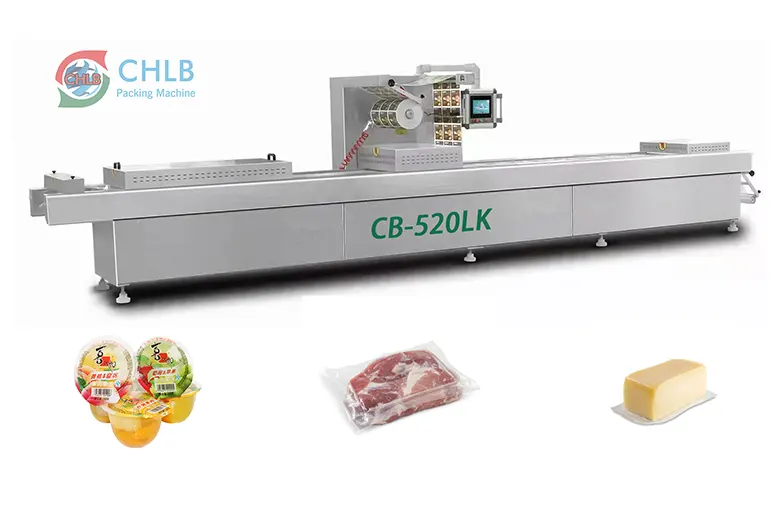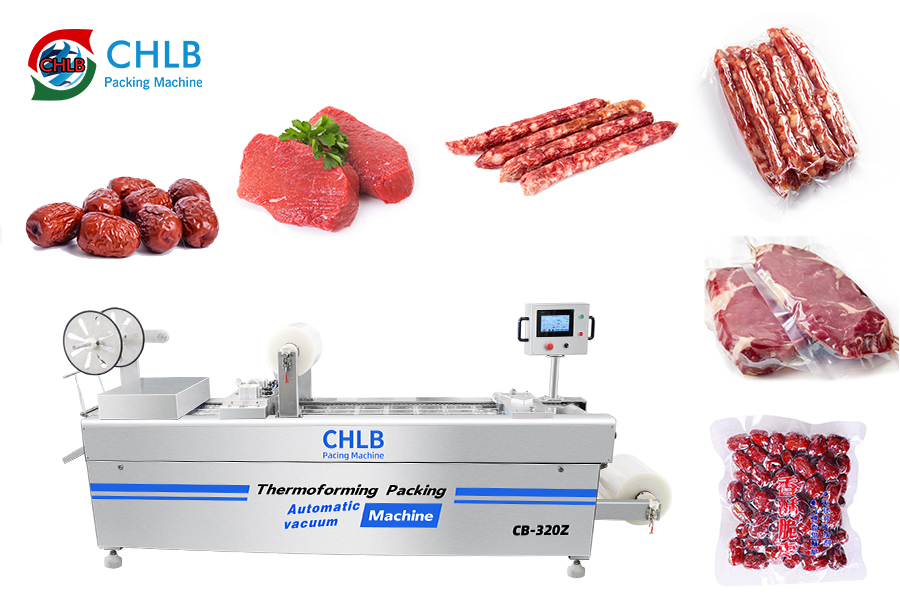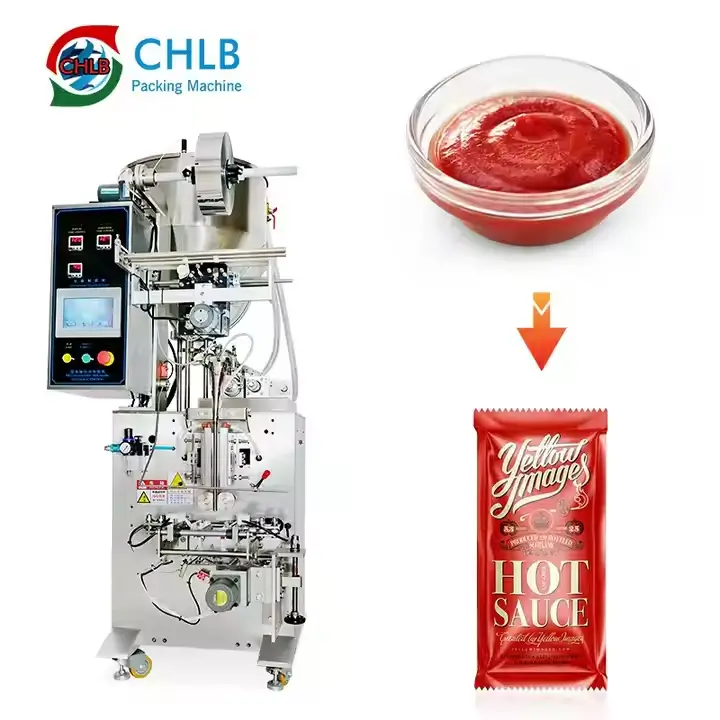No reino da moderna embalagem de alimentos, Máquinas de termoformação desempenham um papel fundamental, Oferecendo soluções versáteis para empresas que visam fornecer soluções de embalagem eficientes e atraentes. Este guia mergulha profundamente nos meandros da máquina de termoformação para embalagem de alimentos, explorando seus tipos, componentes, Materiais, processo, vantagens, e considerações para selecionar a máquina certa.
O que é termoformagem?
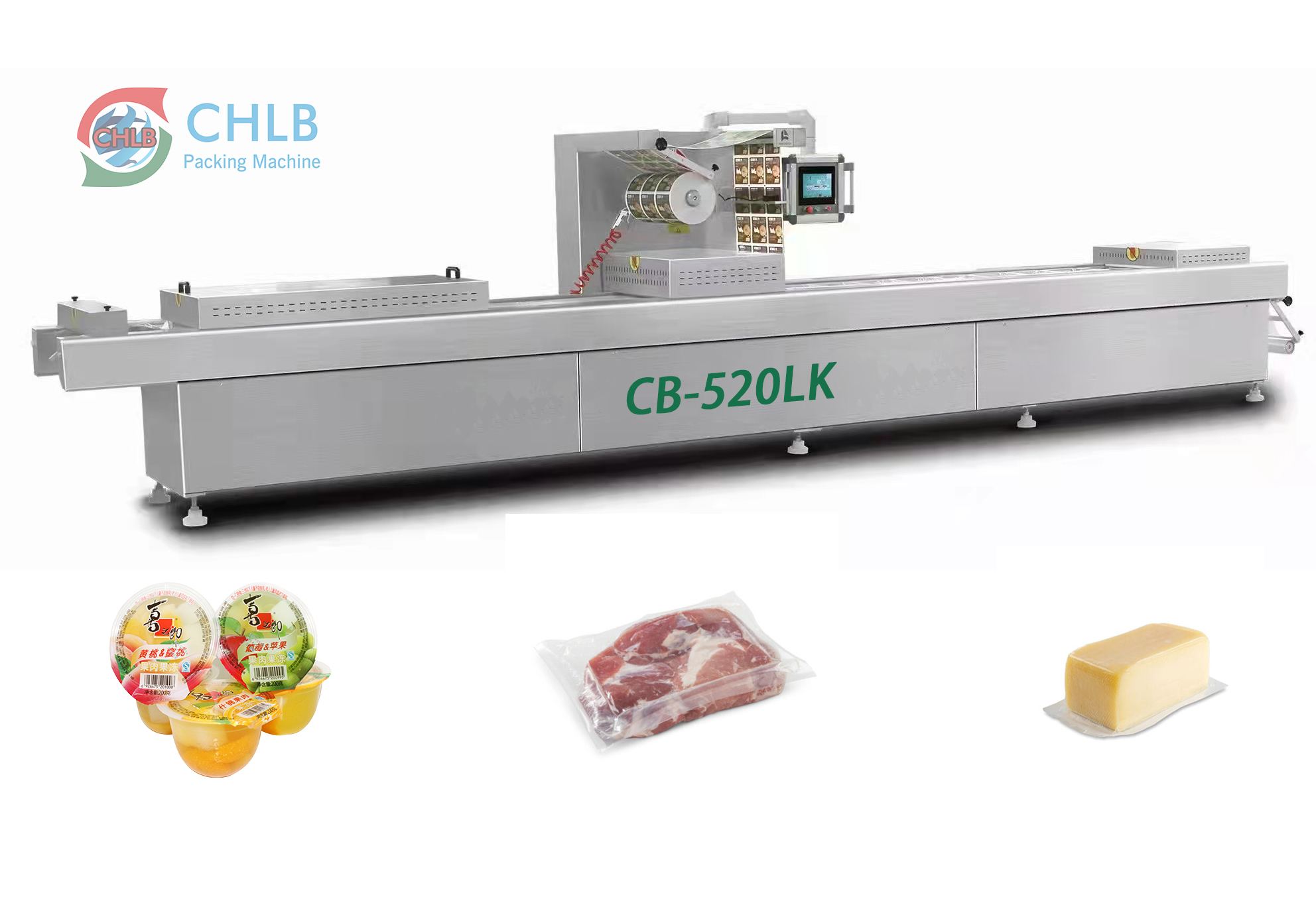
Thermoforming é um processo de fabricação usado extensivamente na embalagem, onde uma folha termoplástica é aquecida a uma temperatura flexível de formação, formado em uma forma específica usando moldes, e aparado para criar o produto final. Este método é amplamente adotado devido à sua versatilidade e custo-efetividade na produção de soluções de embalagem personalizadas.
Tipos de máquinas de termoformação
Máquinas de formação de vácuo
A formação de vácuo envolve aquecer uma folha de plástico até que se torne flexível, Em seguida, usando pressão de vácuo para moldá -lo sobre um molde. Este método é ideal para produzir peças rasas, como bandejas, Blister pacotes, e conchas de molas usadas na embalagem de termoformação.
As máquinas de termoformação a vácuo são amplamente usadas na embalagem de vários produtos alimentares devido à sua capacidade de criar formas e tamanhos personalizados com eficiência.
Máquinas de formação de pressão
A formação de pressão utiliza o vácuo e a pressão para criar peças mais detalhadas e duráveis do que a formação de vácuo padrão. É adequado para projetos complexos e materiais mais espessos, oferecendo estética aprimorada e integridade estrutural. Essas máquinas são ideais para produzir soluções robustas de embalagem de alimentos que requerem um nível mais alto de durabilidade e precisão.
Máquinas de termoformação de dois lençóis
Termoformagem de duas folhas de duas, Então selando-os juntos para criar uma parte de parede dupla. Este método é usado para criar produtos com espaços ocos ou propriedades isoladas. É empregado na produção de recipientes e bandejas que requerem propriedades de isolamento ou barreira, aprimorando os recursos da embalagem de alimentos termoformados.
Principais componentes de uma máquina de termoformação
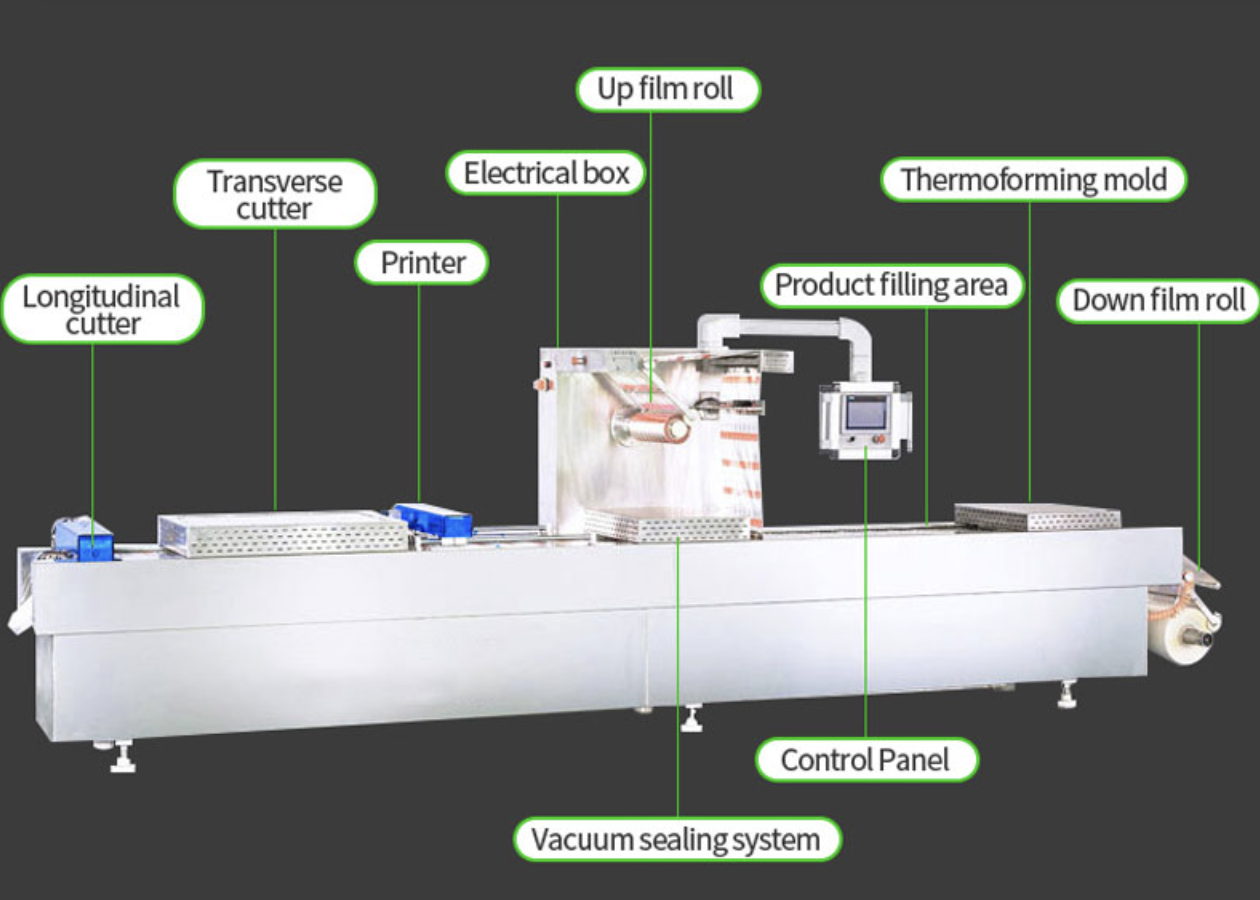
Elementos de aquecimento
Máquinas de termoformação utilizam vários elementos de aquecimento, como cerâmica, quartzo, e aquecedores infravermelhos para aquecer as folhas de plástico uniformemente. O controle preciso da temperatura é fundamental para alcançar resultados consistentes de formação e garantir a qualidade da embalagem termoformada.
Estações de formação
As estações de formação variam em complexidade e capacidade, permitindo a personalização em formas e tamanhos de moldagem com base em requisitos específicos de embalagem. Máquinas modernas oferecem moldes ajustáveis e parâmetros de formação para acomodar diversas necessidades de embalagem, de bandejas simples a complexos recipientes.
Estações de corte
As estações de corte utilizam ferramentas de corte para remover o excesso de material das peças formadas, garantir bordas limpas e dimensões precisas. O corte preciso é essencial para alcançar a uniformidade e o apelo estético em embalagem de alimentos termoformados, aprimorando a apresentação e funcionalidade do produto.
Sistemas de controle
Sistemas de controle avançado automatizam o processo de termoformação, melhorar a eficiência e reduzir o erro humano. Interfaces de usuário intuitivas simplificam a operação e manutenção da máquina, Melhorando a produtividade geral e a satisfação do operador.
Materiais usados em termoformagem para embalagem de alimentos
BICHO DE ESTIMAÇÃO (Tereftalato de polietileno)
O animal de estimação é amplamente utilizado para sua clareza, força, e propriedades de barreira, tornando -o adequado para embalagens de bebidas, saladas, e itens de padaria.
Pp (Polipropileno)
PP oferece excelente resistência à umidade e produtos químicos, Tornando -o ideal para embalar xícaras de iogurte, recipientes de delicatessen, e bandejas de alimentos para microondas.
Ps (Poliestireno)
Ps é leve e versátil, comumente usado para embalar bandejas de carne, Cartons de ovos, e recipientes descartáveis de alimentos.
Processo de termoformação
#1: Pré-processamento
Seleção de material: Escolher o material termoplástico certo é crucial para alcançar propriedades desejadas, como clareza, durabilidade, e reciclabilidade em embalagens de alimentos termoformadas.
Extrusão de folhas: Extrusing de folhas plásticas de espessura uniforme as prepara para o processo de termoformação, garantir a consistência na qualidade do produto.
#2: Formação
Aquecimento: Aquecendo as folhas termoplásticas para a temperatura ideal de formação suaviza -as, tornando -os flexíveis para moldar.
Moldagem: A aplicação de vácuo ou pressão molda os lençóis aquecidos na forma desejada, em conformidade com os contornos do molde para dimensões precisas de embalagem.
#3: Aparando e acabando
Técnicas de corte: Aparar o excesso de material de peças formadas usando ferramentas de corte ou matrizes garante bordas limpas e uniformidade em embalagens de alimentos termoformadas.
Controle de qualidade: A implementação de procedimentos rigorosos de inspeção e teste garante que os produtos acabados atendam aos padrões de qualidade, Garantir a satisfação do cliente e a conformidade com os requisitos regulatórios.
Vantagens de máquinas de termoformação em embalagens de alimentos
A termoformação supera os métodos tradicionais, como moldagem por injeção e moldagem por sopro em termos de flexibilidade, relação custo-benefício, e velocidade, tornando -o uma escolha preferida para Aplicações de embalagem de alimentos.
- Custo-benefício: Thermoforming oferece custos de ferramentas mais baixos e ciclos de produção mais rápidos em comparação com outros métodos de moldagem, tornando-o econômico para pequenas a produção em larga escala corridas.
- Flexibilidade no design: A capacidade de criar formas personalizadas, tamanhos, e texturas permite projetos inovadores de embalagens que aprimorem a visibilidade do produto e o apelo ao consumidor.
- Velocidade e eficiência: Máquinas de termoformação podem produzir altos volumes de embalagem rapidamente, atendendo a cronogramas de produção apertados e demandas de mercado de maneira eficaz.
- Proteção aprimorada do produto: A embalagem termoformada fornece excelentes propriedades de barreira contra a umidade, oxigênio, e contaminantes, prolongando a vida útil e garantir o frescor do produto.
Escolhendo a máquina de termoformação certa
Avaliando suas necessidades
Avalie seus requisitos de produção, Preferências materiais, e volumes de saída desejados para selecionar uma máquina de termoformação que se alinha aos seus objetivos de negócios.
Principais recursos a serem procurados
Considere fatores como recursos de aquecimento, formação de configurações da estação, opções de corte, e recursos de automação ao escolher um máquina de embalagem termoformadora.
Considerações orçamentárias
Balance os custos iniciais de investimento com economia operacional a longo prazo e eficiência de produção para maximizar o ROI em embalagens de alimentos termoformadas.
Reputação e suporte do fabricante
Escolher um fabricante e fornecedor de máquinas de termoformagem respeitável conhecido por confiabilidade, Suporte técnico, e atendimento ao cliente responsivo para garantir operações suaves e a longevidade da máquina.
Conclusão
Máquinas de termoformação são ferramentas indispensáveis na indústria de embalagens de alimentos, oferecendo versatilidade incomparável, eficiência, e custo-benefício. Ao entender os tipos, componentes, Materiais, Processar meandros, e vantagens da termoformagem, As empresas podem tomar decisões informadas para aprimorar seus recursos de embalagem e atender às demandas em evolução do consumidor por soluções de embalagem de alimentos termoformadas.
Perguntas frequentes na máquina de termoformação para embalagem de alimentos
1. Que tipos de produtos alimentícios são comumente embalados usando termoforming?
A termoformação é amplamente usada para embalagens de produtos, como carnes, queijos, itens de padaria, produtos frescos, e refeições prontas para consumo devido à sua capacidade de fornecer soluções de embalagem protetora e atraente.
2. Como a termoformação contribui para práticas de embalagem sustentáveis?
Thermoforming permite o uso de materiais recicláveis e uso de material otimizado, reduzindo o impacto ambiental em comparação com os métodos de embalagem tradicionais.
3. Quais são as principais considerações ao escolher entre a formação de vácuo e as máquinas de formação de pressão?
A formação de vácuo é adequada para peças rasas e produções de menor volume, Enquanto a formação de pressão oferece detalhes e durabilidade aprimorados para projetos complexos e materiais mais espessos em embalagens de alimentos termoformadas.
4. Como a automação em máquinas de termoformação pode melhorar a eficiência da produção?
A automação reduz o trabalho manual, minimiza erros, e aumenta a taxa de transferência, permitindo ciclos de produção mais rápidos e qualidade consistente em embalagens de alimentos termoformadas.
5. Qual o papel que a seleção de materiais desempenha na termoformagem para embalagens de alimentos?
A escolha do material termoplástico certo garante que a embalagem atenda aos padrões de segurança alimentar, oferece propriedades de barreira apropriadas, e aprimora a vida útil do produto e a apresentação.

